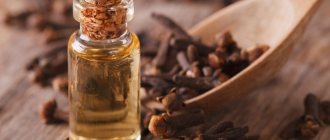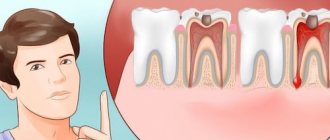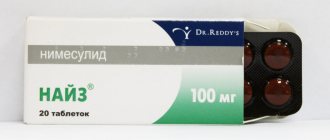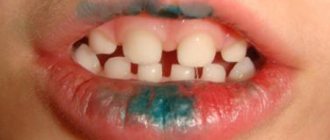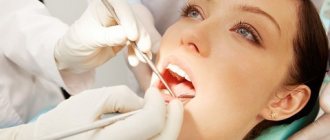Sore gums, the presence of an active inflammatory process and discomfort are a serious problem that requires an immediate solution. But in some cases, it is not possible to immediately consult a doctor, so there is a need to select a safe and effective remedy to relieve painful symptoms. In this case, Furacilin, which is used to rinse the gums, will come in handy.
Furacilin is an effective antibacterial drug that will help neutralize pathogenic flora that has developed in the oral cavity, and will also reduce the severity of the inflammatory process. Furacilin is especially effective for gingivitis, gumboil, when gum inflammation has worsened due to rotting pieces of food that have fallen into the gum pocket.
It is worth noting that rinsing is not the only way to solve the problem; rinsing will only help reduce pain and partially eliminate inflammation.
Choosing a gum rinse
Mouthwashes can be therapeutic, that is, intended for the treatment of specific diseases, and prophylactic, which are recommended by dentists as an additional means of caring for the oral cavity. It is better to select the first ones under the supervision of a doctor, taking into account the individual characteristics of the course of the disease. The latter can be divided into 4 types:
- for the prevention of caries;
- for teeth whitening;
- for gum treatment;
- for comprehensive protection of gums and teeth.
When choosing a mouthwash for each specific purpose, give preference to well-known manufacturers and carefully read the instructions for use. Startsmile recommends.
- CURASEPT ADS 205. Gum rinse contains fluorides and vitamin C. Protects against caries and is not addictive. Recommended for comprehensive care of braces and dentures.
- 4-action Mouthwash. Biorepair offers the ideal rinse option for teeth and gums that are hypersensitive. The rinse restores enamel and prevents caries.
- Paroguard CHX Miradent. Has a pronounced anti-inflammatory effect. Contains chamomile extract. Does not require dilution with water, which makes it convenient for travel or business trips.
- PresiDENT Profi. Therapeutic solution for rinsing gums based on Chlorhexidine. Does not contain ethanol. Suitable for irrigator. Recommended as a rinse for gum periodontal disease.
- "Prevention of gum disease" Donfeel. Can be used for daily care. Removes plaque, has a bactericidal effect and promotes mucosal regeneration.
ATTENTION!
Exceeding the concentration of ethanol in the mouthwash provokes dryness of the oral mucosa!
Treatment with Furacilin
In case of facial swelling, it is not recommended to apply any hot compresses, since such a procedure will only aggravate the problem and the inflammatory process will significantly intensify.
It will not be possible to cure gingivitis or flux on your own, as this is fraught with the development of an extensive inflammatory process and the spread of infection to nearby tissues. It is necessary to consult a dentist; thanks to comprehensive treatment procedures, it will be possible to eliminate swelling of the gums and maintain dental health.
When treating flux, anti-inflammatory drugs are usually used, namely Furacilin solution. You can prepare the solution yourself, or purchase a ready-made rinse at the pharmacy.
To prepare an antibacterial solution yourself, you will need to dissolve one tablet of the drug in 200 ml of hot (boiled) water. After all the particles of the tablet have completely dissolved, you can carry out the rinsing procedure.
Medicinal solutions for rinsing teeth and gums
You will achieve greater results if you start using an irrigator to rinse your gums - a device that delivers liquid into the oral cavity under pressure. For this purpose, it is best not to use self-prepared rinses based on medicinal herbs, which can clog the filter, but to use ready-to-use pharmaceutical medicines for rinsing the gums.
Chlorhexidine
The use of chlorhexidine for rinsing gums is common in dentistry. It effectively copes with the symptoms of inflammation and has an affordable price. Patients are often interested in the question: how to dilute chlorhexidine? In this case we are talking about an aqueous 0.05% solution, so dilution with water is not required. It is recommended to use after each meal and for at least one minute.
Rotokan
For rinsing, rotokan is used in the form of an alcohol tincture based on plant extracts at least 3 times a day. You will need 1 teaspoon of the product per 200 milliliters of boiled warm water. Do not swallow!
Furacilin
Furacilin for rinsing gums is most often used in tablets: crush 1 tablet, pour a glass of hot water until completely dissolved, cool to body temperature and rinse your mouth after eating.
Stomatophyte
An alcohol tincture containing extracts of 7 medicinal plants. Requires dilution with water at the rate of 1 measuring cup per 50 milliliters of warm boiled water. Rinsing with Stomatofit is prescribed 3 times a day. Not suitable for children under 12 years of age!
Miramistin
Rinsing the gums with Miramistin is carried out at the rate of 10 milliliters of solution per 25 milliliters of boiled water. You should not eat for an hour after the procedure. Use as a mouth rinse for no longer than 5 days in a row, otherwise Miramistin begins to inhibit the beneficial microflora in the mouth.
Chlorophyllipt
Chlorophyllipt for rinsing is used in the form of an alcohol solution based on a strong natural antiseptic - eucalyptus extract. It is recommended to use it no earlier than half an hour after meals, preparing a mouthwash at the rate of 1 tablespoon per glass of warm water.
Inflammation of a wisdom tooth
The most problematic for most people are the third molars of the lower dentition, which are commonly called “wisdom teeth.” The upper “eights” relatively rarely become a source of serious problems, but the lower ones are a real headache not only for people, but also for dentists. Their correct treatment or removal requires the doctor to have a lot of experience, skill and, to some extent, wisdom, which once again confirms the accuracy of the popular name for eights.
Lower third molars: history of the problem
Why are the third lower molars so problematic, why does inflammation of the gums near the wisdom tooth occur in almost every second inhabitant of the planet? This is our payment for a comfortable lifestyle, in particular, for changed eating habits. Modern food is very different from what our ancestors ate even a few hundred years ago. Heat treatment made the food soft, making long chewing unnecessary. Children often swallow food without chewing it properly.
What is the result? As a result, the lower jaw does less work, and for the body this becomes a signal that its development can be slowed down, because there is no need for a massive mandibular bone. As a result, it becomes smaller than nature intended. The number eight, which is the last to erupt, has no room left for normal growth and development. Hence the typical problems - retention, dystopia, gum inflammation, almost inevitable pain during teething.
Alarming symptoms
The eruption of the figure eight is often accompanied by pain. But what exactly does a person hurt? Dental tissue, gums near the wisdom tooth, bone tissue of the lower jaw? Or do neighboring elements of the dentition hurt, on which the problematic third molar puts pressure?
The gums near the wisdom tooth hurt. The area of gum that covers the third molar has its own name. It is commonly called the gingival hood. Very often the molar cannot overcome the resistance of the hood and a problem arises. The wisdom tooth does not fully erupt (in this case it is called impacted), and the gums above it become inflamed. Inflammation of the gums near the wisdom tooth is called pericoronitis.
Pain is the first and main symptom of inflammation, but it is far from the only one. In many patients, the gums become swollen, and along with it, the nearby soft tissues of the cheek swell. As a result, the entire middle third of the face on the side of inflammation becomes swollen. Pain often occurs when swallowing and chewing food.
Redness of the gums is another clinical sign that unmistakably indicates the development of an inflammatory process. If you wait too long to seek help from a specialist, purulent inflammation develops, which indicates an infection. Discharge of pus from under the gingival hood and bad breath are symptoms of a purulent-inflammatory process. In the future, the infection can spread to neighboring tissues, including the jawbone.
Treatment Options
If your gums near your wisdom tooth are inflamed, it is better to immediately contact the nearest dental clinic or medical center where you will receive the necessary assistance. The first step should be x-ray diagnosis. If your dentist plans to treat you without an x-ray, consult another specialist.
An x-ray will show exactly how the third molar is growing and erupting. If it grows at an angle in the direction of the second molar, if it “lies” and literally crashes into the adjacent element of the dentition, it needs to be removed. Otherwise, there is a high probability of developing malocclusion, destruction of enamel and carious lesions of the second molar, as well as other problems with the lower dentition and the dental system as a whole.
It should be said that the situation described above with dystopia (abnormal position and direction of growth) is not uncommon. Dystopia of the figure eight occurs very often. If left unattended, sooner or later it will lead to other more serious problems requiring expensive, lengthy and tedious dental treatment.
Is it possible to do without deletion? Certainly. If the molar is growing in the right direction and is not pressing on its neighbor, there is no need for extraction. In this case, the dentist will choose the following algorithm of actions:
- Prescribe anti-inflammatory drugs, painkillers and antihistamines to reduce gum swelling.
- The area of gum above the figure eight is removed to facilitate its eruption. Important! Removal is possible only if there is no infection.
- With the development of a purulent-inflammatory process, antibiotics are prescribed.
- In case of infection, the gingival hood is not removed, but dissected to improve the outflow of pus. After suppressing the pathogenic flora, gum excision is performed.
The cost of therapeutic treatment of gum inflammation near a wisdom tooth is low - about 2,500 rubles. Hood dissection is a painless procedure performed using local anesthetics. After a visit to the dentist, it is enough to follow his recommendations: take medications prescribed by the doctor, regularly rinse your mouth with antiseptic solutions, apply dental gels with anti-inflammatory and antibacterial effects to the inflamed area of the gums.
Wisdom tooth removal
If the position and direction of growth are abnormal, removal of the third molar is indicated. Since it is a vestigial organ, its absence will not in any way affect the function of the dental system, while abnormal growth can lead to malocclusion and other serious problems.
Removing a wisdom tooth is a complex procedure. The figure eight has a powerful root system and is firmly anchored in the jaw bone. The roots are often curved, making the extraction process more difficult. However, dentists have an expression that a good doctor turns a complex extraction into an easy procedure for the patient, but an inexperienced dentist makes a simple extraction difficult and painful. It is very important to contact a qualified specialist!
The presence of a well-developed root system requires special preparation for removal. It involves drilling or crushing the area of bone that holds the roots. A good tactic is sawing the crown; fragments are much easier to remove than the entire tooth.
The cost of complex extraction of impacted and dystopic wisdom teeth varies from 6 to 12 thousand rubles. This price includes anesthesia benefits. The procedure is performed under conduction or infiltration anesthesia; most often, local anesthetics based on articaine (Ultracaine, Ubistezin) are used for these purposes. The extraction lasts 15-20 minutes, but if the doctor does not have the proper experience, the process can even take a couple of hours.
Is it painful to have a third molar removed? According to most patients, it is a little scary, but not painful at all. Psychological discomfort, of course, is present, but there is no pain. Patients who are terrified of dental procedures may be offered sedation or anesthesia, but this is extremely rarely necessary.
After removal
After the procedure, you must follow a few simple rules. First, you should abstain from eating for three or four hours. Smokers must abstain from smoking during this time. You can drink water within an hour and a half after the operation.
In the future, you need to eat soft food for one or two days. Food should not be hot or cold, ideally its temperature should be close to body temperature. Chew food on the healthy side to avoid washing out the blood clot. Formation of a blood clot in the socket is an important part of the healing process. To speed up the healing dynamics, ask your dentist to place one or two sutures on the gum above the hole before extraction. It doesn't hurt, but it's very effective.
Pain after removal cannot be completely avoided; it will make itself felt after the anesthetic wears off. Fortunately, postoperative pain is not severe and can be easily relieved with conventional analgesics. Doctors often prescribe Ketanov or its analogues in injection form to patients. Antibiotics are prescribed to prevent infection; this is especially true in the presence of a purulent-inflammatory process.
Regular rinsing with antiseptic solutions will help suppress the vital activity of pathogenic microflora. Chlorhexidine, which is sold in any pharmacy, is well suited for these purposes. Gels or creams with anti-inflammatory and antibacterial effects should also be applied to the surface of the gums. Please note that you need to rinse your mouth carefully so as not to provoke the blood clot to be washed out of the hole. The procedure is more similar to baths than to the usual rinses.
The body temperature remains elevated after removal. A normal reaction to surgery is weakness and general malaise. There is no need to worry about minor bleeding from the wound. After three to five days, the condition returns to normal, the bleeding stops, and the pain no longer bothers you.
You can learn more about the treatment of inflammation of the gums near the wisdom tooth by consulting a medical dentist.
What to prepare for rinsing gums at home?
Chamomile
A powerful natural antiseptic used to eliminate inflammation. Among herbs for rinsing gums, chamomile occupies a leading place.
How to use:
Pour 1 tablespoon into a glass of boiling water, let it brew for 40 minutes and rinse 3 times a day after meals.
Oak bark
Oak bark is an indispensable rinse for gums. Has an astringent and hemostatic effect.
How to use:
Pour 3 tablespoons of bark into a glass of boiling water, keep in a water bath for half an hour, strain, bring the volume to 200 milliliters with boiled water and rinse 5 times a day after meals.
Sage
Rinsing with sage has a pronounced anti-inflammatory effect.
How to use:
Pour 200 milliliters of boiling water over 1 tablespoon of leaves, leave for 40 minutes, rinse 3 times a day after meals.
Baking soda
A baking soda rinse for gums reduces pain and promotes healing.
How to use:
1 teaspoon per glass of boiled water. If your gums are inflamed, rinsing with soda should be done after eating, after brushing your teeth. Use immediately, do not store!
Salt
Rinsing gums with salt has a disinfecting effect.
How to use:
1 teaspoon of salt per 1 glass of boiled water. To enhance the medicinal effect, it is best to rinse with salt and soda at the same time!
5% iodine solution
Has an antimicrobial effect.
How to use:
To rinse your gums with iodine, one drop per glass of boiled water is enough. It is better if it is lightly salted, for example, sea salt.
Propolis
The waste product of bees relieves pain well and heals wounds.
How to use:
Propolis for rinsing gums is used in the form of an alcohol tincture: 30 drops per 1 glass of boiled water, rinse 3 times a day after meals.
If you don’t have time to brew herbs, you can just as easily use pharmaceutical alcohol tinctures made from them to rinse your gums.
Features of rinsing
You need to rinse your mouth for at least 5 minutes, this is how long it will take for the antiseptic to penetrate the upper layers of tissues and mucous membranes. The frequency of rinsing is from 3 to 5 times.
Remember: the more often you rinse your mouth, the faster you will be able to relieve inflammation and relieve pain.
You cannot make a concentrated antiseptic solution; in this way you will not be able to increase the effectiveness of the drug; strictly follow the recommendations described in the instructions.
To make treatment with Furacilin more effective, you can add decoctions of medicinal herbs, essential oils, and alcohol tinctures (for example, calendula) to the solution.
It is not recommended to eat food for half an hour after rinsing the mouth, this way you will allow the drug to penetrate into the tissues and have a therapeutic effect.
